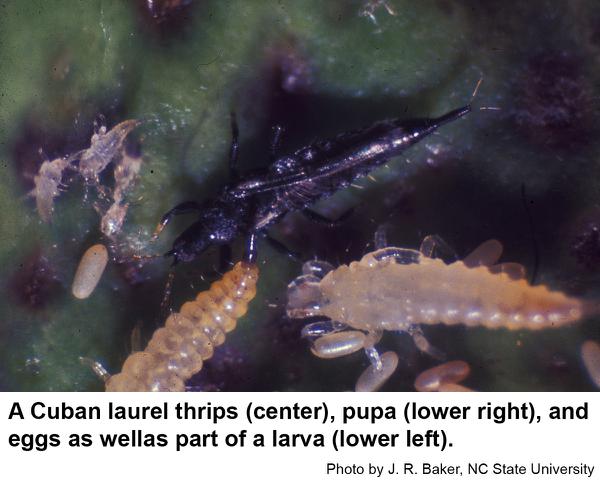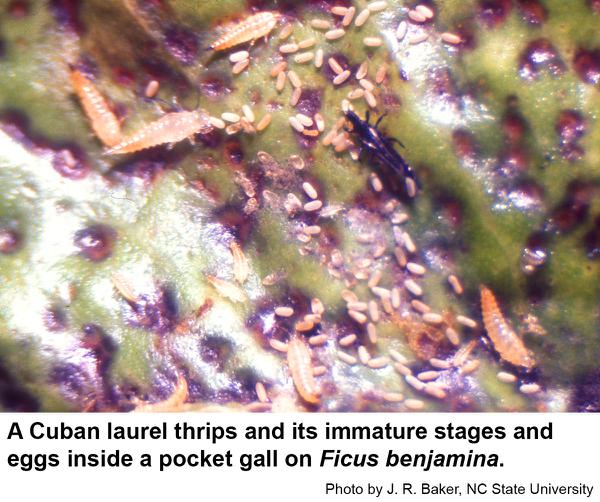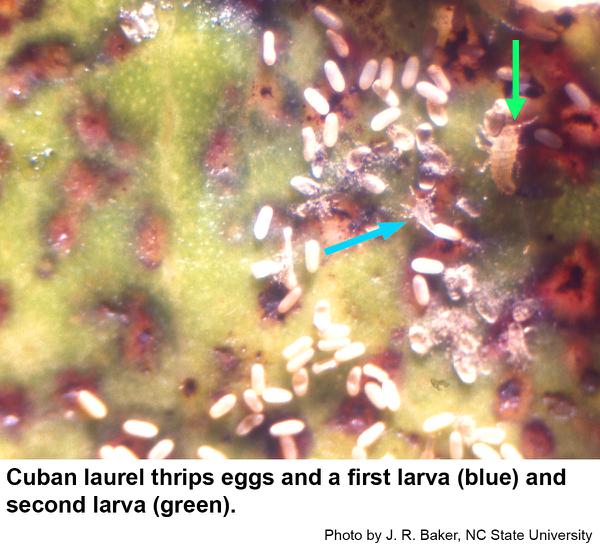Description and Biology
The Cuban laurel thrips, Gynaikothrips ficorum, is a large (up to 1/8 inch), dark brown to black, elongate insect. The egg is cylindrical with rounded ends, smooth, and translucent white. The first stage larva is a tiny, translucent white insect. In top view the first stage larva is almost oval. Second stage larvae are also translucent white but are similar to the adult in size and shape. Both stages have red eyes. The abdominal segments taper from the thorax. In top view the second stage larvae are shaped like an elongate diamond. The posterior tube becomes dark in older larvae and is held pointing up. Thrips have two pupal stages. Prepupae are similar to second stage larvae except that the wing buds are externally visible. Pupae have longer wing buds and the antennae are folded back over the head. These thrips feed on the tender new growth on the top surface of the leaves. Each place a thrips feeds, a tiny purplish pit is formed. If enough feeding occurs, the top surface of the leaf stops growing and the bottom surface continues to grow so that the leaf curls upward forming a roll or pocket inside of which the thrips feed and mature. Development from egg to egg-laying females takes about 30 days. Adult Cuban laurel thrips are active fliers and migrate readily during hot weather. Like some other thrips, the Cuban laurel thrips also bites people causing temporary discomfort.
Host Plants
Cuban laurel thrips feed on Indian laurel, weeping fig, India rubber plant, other figs, as well as various shrubs, herbs, and orchids. In the floriculture industry, weeping fig is the host most often infested. This thrips may not kill the plant it infests, but it certainly does reduce the quality of its appearance.
Residential Recommendations
Clipping off and destroying all the galled leaves and all of the tender new growth is one cultural control for Cuban laurel thrips. Since this thrips can successfully infest only the new growth, any remaining thrips die before the plant can put out new growth. The Cuban laurel thrips is susceptible to those pesticides labeled for thrips control. Two or three thorough applications about 5 to 7 days apart should give complete control. The combination of pruning off the galled leaves and applying one thorough application of some sort of pesticide labeled for thrips on ornamentals would be good bet by eliminating the unsightly galls and the thrips all at once.
References
- Common name: leaf-gall thrips of Ficus, scientific names: Gynaikothrips ficorum (Marchal) and Gynaikothrips uzeli (Zimmerman) (Insecta: Thysanoptera: Phlaeothripidae). Funderburk, J. E. et al. 2017 (revised). Featured Creatures. Entomology & Nematology, FDACS/DPI, EDIS. Publication Number: EENY-324.
- Insect and Related Pests of Flowers and Foliage Plants. Baker, J. R. ed. 1994 (revised). NC Cooperative Extension Service pub. AG-136.
- Extension Plant Pathology Publications and Factsheets
- Horticultural Science Publications
- North Carolina Agricultural Chemicals Manual
For assistance with a specific problem, contact your local Cooperative Extension Center.
This Factsheet has not been peer reviewed.
Publication date: Jan. 14, 2017
Reviewed/Revised: Sept. 13, 2019
Recommendations for the use of agricultural chemicals are included in this publication as a convenience to the reader. The use of brand names and any mention or listing of commercial products or services in this publication does not imply endorsement by NC State University or N.C. A&T State University nor discrimination against similar products or services not mentioned. Individuals who use agricultural chemicals are responsible for ensuring that the intended use complies with current regulations and conforms to the product label. Be sure to obtain current information about usage regulations and examine a current product label before applying any chemical. For assistance, contact your local N.C. Cooperative Extension county center.
N.C. Cooperative Extension prohibits discrimination and harassment regardless of age, color, disability, family and marital status, gender identity, national origin, political beliefs, race, religion, sex (including pregnancy), sexual orientation and veteran status.




